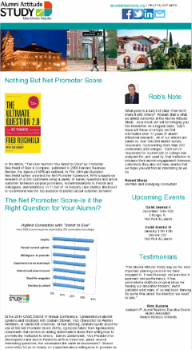Not all alumni have the same experience of their alma mater, either as a student or as an alumnus/a. For every individual, each experience is filtered through their individual and cultural lens. Research reveals, however, that there are similarities (of such perceptions) among members of distinct demographic groups. A few of the most important demographic distinctions for alumni groups are age, area of study, and ethnicity. The better we are at targeting our communications to these unique distinctions, the better we will be at engaging those cohorts of alumni.
Our alumni feedback projects usually show distinctions about the best ways to engage older alumni versus younger (age-based) or engineers versus nurses or teachers (field of study-based). However, sometimes we do not have as much data by ethnic group and in those cases, are unable to isolate differences between ethnic groups for individual clients. On the other hand, in aggregate we can see some interesting differences in the way alumni from different ethnic groups feel about their alma mater. The rest of this article is devoted to probing some of those differences. Data for the analysis are based on a set of alumni responses from 2009 through 2013 that includes 230,000 alumni responses from 79 different projects.
First, there are differences in how alumni utilize different avenues of communication. While all ethnic groups reporting indicate a preference for reading the alumni magazine, Caucasian alumni read the magazine with greater frequency than other ethnic groups. Younger alumni tend to read the magazine less frequently than older alumni and the differences between the age groups is most pronounced among Caucasians.


These usage patterns contrast rather significantly with perception of importance. Across all demographic groups, African American alumni are most likely to say that the magazine is important to them, although they collectively also report the lowest frequency of reading (the magazine). Clearly, this is something to consider when making your alumni communication choices. In fact, for six of the ten communication criteria we regularly look at, African Americans attribute the highest level of importance.
Another interesting difference between ethnic groups is how they view solicitation and invitations to alumni activities. As expected, alumni want more invitations and fewer solicitations. Interestingly, Caucasian alumni are less likely to say they are getting too many solicitations than the other three ethnic groups and Asian alumni are the most likely to feel like they are getting too many solicitations.


On the other hand, Hispanics are most likely to want more invitation to events. This is consistent with the fact that Hispanic alumni have the highest satisfaction index of all the ethnic populations (See blog post by Jonathan Gaines). Also note that the Caucasian alumni are the most passive on both issues. They are least bothered by solicitations and least anxious for more invitations.
In another question, we ask alumni about their perceived importance of invitations and how well their alma mater does at providing them. Since most alumni will never attend an event, the interest in invitations is really a statement about their interest in knowing that the event is happening. For all of the ethnic groups shown, younger alumni have more interest in invitations even though they are the least likely to attend events. This is most evident for African Americans and Hispanics.

Several of our clients have ethnicity-based alumni groups. We have presented findings to these different groups based on their specific alumni feedback. In these presentations we observe a noticeable increase in energy level over the “normal” presentation. Clearly, there is more political pull to focus on groups like the business school alumni or law school alumni, but our data indicate there might be more upside to focusing on other longitudinal (alumni affinity that goes across many different ages and years of graduation) groups like African American alumni, Hispanic alumni, or Asian alumni. Our data show that, collectively, these groups are indeed different (perceptually speaking) and also have differing needs. Focusing on the specific needs of each group can greatly increase your success in developing the most effective programs and communications possible.
As universities and colleges seek to enhance their use of longitudinal affinity models, ethnicity should be an obvious and high priority choice. We know that many universities and colleges are having great successes targeting programs for different ethnic groups, while others are wondering how to improve their effectiveness in these segments. We invite you to continue this discussion by commenting to this post about successes you are having with programing focused on increasing engagement within different ethnic groups.
Follow Us On





